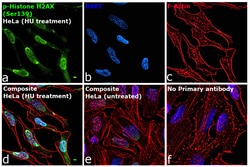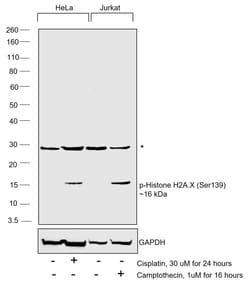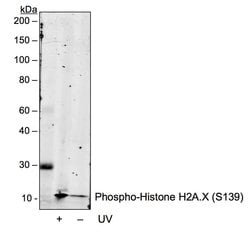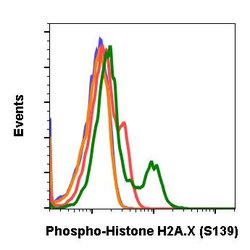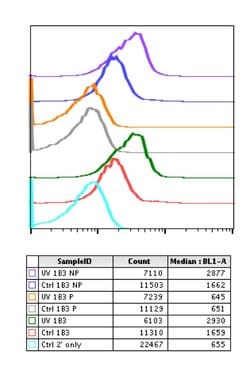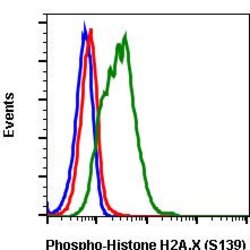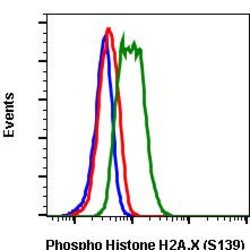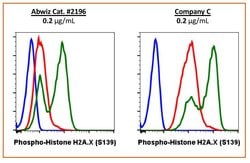Learn More
Invitrogen™ Phospho-Histone H2A.X (Ser139) Recombinant Rabbit Monoclonal Antibody (HisH2AXS139-1B3)


Rabbit Recombinant Monoclonal Antibody
$408.50 - $639.50
Specifications
| Antigen | Phospho-Histone H2A.X (Ser139) |
|---|---|
| Clone | HisH2AXS139-1B3 |
| Concentration | 0.5 mg/mL |
| Content And Storage | -20°C |
| Applications | Flow Cytometry, Western Blot, Immunocytochemistry |
| Catalog Number | Mfr. No. | Quantity | Price | Quantity & Availability | |||||
|---|---|---|---|---|---|---|---|---|---|
| Catalog Number | Mfr. No. | Quantity | Price | Quantity & Availability | |||||
|
PIMA528007
|
Invitrogen™
MA528007 |
200 μL |
Each for $639.50
|
|
|||||
PIMA537023
 |
Invitrogen™
MA537023 |
20 μL |
Each for $408.50
|
|
|||||
Description
Recombinant rabbit monoclonal antibodies are produced using in vitro expression systems. The expression systems are developed by cloning in the specific antibody DNA sequences from immunoreactive rabbits. Then, individual clones are screened to select the best candidates for production. The advantages of using recombinant rabbit monoclonal antibodies include: better specificity and sensitivity, lot-to-lot consistency, animal origin-free formulations, and broader immunoreactivity to diverse targets due to larger rabbit immune repertoire.
Histone H2A.X (H2AX) is a member of the histone H2A family which is one of the four core histones making up the nucleosome core particle. In eukaryotes, DNA double strand breaks (DSBs) have been shown to trigger the phosphorylation of serine 139 at the carboxy terminus of histone H2AX resulting in gamma-H2AX. The phosphorylation of H2AX can be detected by Western blotting or immunofluorescence, revealing the frequency of DSBs. The phosphatidylinositol 3-kinases have been implicated in H2AX phosphorylation, but it is unclear if ATM is the primary H2AX kinase or if other members of the family such as DNA-PK and ATR contribute in a similar manner. Structurally, H2A.x contains 143 amino acid residues. Histone H2A.X is considered a basal histone, being synthesized in G1 as well as in S-phase, and its mRNA contains polyA addition motifs and a polyA tail along with the conserved stem-loop and U7 binding sequences involved in the processing and stability of replication type histone mRNAs. There are two forms of Histone H2A.X mRNA, one about 1600 bases long and contains polyA; the other about 575 bases long, lacking polyA. The short form behaves as a replication type histone mRNA, while the longer behaves as a basal type histone mRNA. Histone H2A.X maps to the 11q23.2-q23.3 region of the human chromosome. Histone H2A.x contributes to histone-formation and therefore the structure of DNA. Histone H2A variant H2A.x specifically regulates the interaction of MDC1 (mediator of DNA damage checkpoint protein 1), a DNA repair protein to the sites of DNA damage.Specifications
| Phospho-Histone H2A.X (Ser139) | |
| 0.5 mg/mL | |
| Flow Cytometry, Western Blot, Immunocytochemistry | |
| Unconjugated | |
| Rabbit | |
| RUO | |
| PBS with 0.1% BSA, 50% glycerol and 0.02% sodium azide; pH 7.4 | |
| P16104, P27661 | |
| 15270, 3014 | |
| A synthetic phospho-peptide corresponding to residues surrounding Ser139 of human phospho histone H2A.X. | |
| Antibody |
| HisH2AXS139-1B3 | |
| -20°C | |
| Recombinant Monoclonal | |
| Liquid | |
| IgG κ | |
| Human, Mouse | |
| H2AX | |
| AW228881; gamma H2AX; gammaH2ax; H2A histone family member X; H2A histone family, member X; H2A.X; H2A.X variant histone; H2A/X; h2afx; H2ax; H2AX histone; Hist5-2ax; histone 5 protein 2ax; histone H2A.x; Histone H2a/x; Histone H2AX; RGD1566119; similar to H2A histone family, member X; zgc:56329 | |
| H2AX | |
| Primary | |
| Protein A/G |
Your input is important to us. Please complete this form to provide feedback related to the content on this product.
